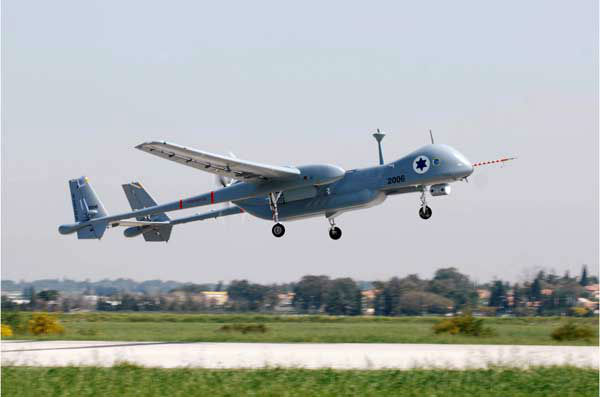Their high strength-to-weight ratio, corrosion resistance and fatigue strength make composite materials an excellent candidate for use in unmanned air vehicle structures.
To this end, all of Israel Aerospace Industries’ UAVs – from the smallest to the largest – are made from composites, although the stress on components such as the wing poses problems for maintenance.
Conventional inspection procedures are difficult to apply in the case of complex composite-based structural components and available non-destructive testing methods require highly trained technicians, which results in high operating costs.
In an exclusive presentation for Flightglobal, Moshe Medina, IAI's executive vice-president and general manager of its engineering and development group, unveiled details of IAI’s new fibre-optic strain-sensing health monitoring system for UAVs, which is based on the Rayleigh backscattering distributed strain sensing technology.
"The new system is based on an embedded fibre-optic that measures the strain distribution on the wing due to external loading," Medina explains.
He says that their small diameter means fibre-optics can easily be embedded within large composite material-based structural components: "They are flexible, passive, tolerant to environmental conditions and insensitive to electromagnetic disturbances."
Medina says that one of the methods is based on measuring the Rayleigh backscattering – in fibre-optics, this effect is caused by random fluctuations in the refractive index of the fibre – as a function of location along the fibre.
The amplitude of the backscattered light as a function of distance is random, but is fixed for any given fibre at a given layout of the fibre, Medina says.
An external stimulus such as mechanical strain or change in the temperature causes a shift in the local reflected optical spectrum. With a spatial resolution on the order of a centimetre, one can monitor strains over tens of meters of standard single mode optical fibres without the need for any preparations.
The structural health monitoring of the wing is performed by comparing the strain signature – measured by the optical fibre – under the same loading condition, at different times during the UAV’s service.
When the different UAV parts are being built in IAI's composite department, the fibre-optic is being embedded into the wing spars and other fuselage parts in spots that tend to develop strain damage.
This system has been embedded in all of the company's Heron TP UAVs – the largest type manufactured by the company – monitoring the health of all the front wing spars of the UAV.

Israel Aerospace Industries
After each flight or series of flights, the end of the fibre-optic is connected to a device loaded with the special algorithm that translates the input from the embedded system, turning it into data that can point to areas that need attention.
"We already know that the system has increased the mean time between inspection by 20%,” Medina notes.
The easy access to the data enables preventive maintenance, and according to Medina, taking the possible human error involved in other methods of periodical inspections "out of the loop".
Health management of UAVs, according to Medina, is crucial: "In a manned platform, the pilots are also sensors that can detect evolving failures. In an unmanned system the health system is alone.”
The new fibre-optic-based health system is not affected by light, ensuring precise readings even in harsh weather.
The new system is already installed on the Israeli air force's Heron TP, and has so far accumulated some 2,000h of flight time. According to the development team, in a sequence of 1,000h, there were no false indications.
The system is now being installed in IAI's UAVs, but other uses are already being evaluated, such as utilisation for monitoring composite fuselage sections of helicopters after cracks have been found and fixed. IAI has also used it to test its Gulfstream G280 business jet that is approaching the end of its fatigue test series.
Positive results have encouraged IAI to take the system to other activities of the company, such as the conversion of passenger aircraft to aerial tankers, cargo aircraft or special mission aircraft. Medina and his team say that the fibre-optic-based health system is a “revolution” that will be found in many aeronautical programmes in the future.
Source: Flight International


























